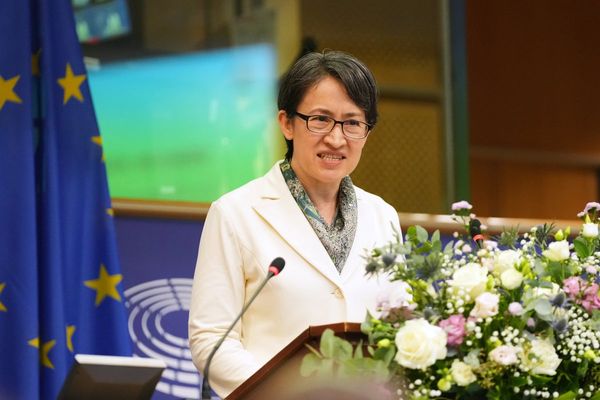
Carlyle Group, a pioneer in the field of private equity, has made several changes since Harvey Schwartz joined two years ago as its chief executive. These changes have boosted Carlyle’s share price and assets under management, and morale is reportedly on the up-and-up at the nearly 40-year-old firm.
“Two to three years of progress has been accomplished in the past year and a half. With key transitions behind us, we’re focused on growth initiatives that will drive a noticeable value creation phase for shareholders,” the company’s CFO, John Redett, told Fortune.
Redett is one of several Carlyle executives whom Schwartz promoted or brought into the C-suite in the last two years. The fresh leadership has helped Carlyle's stock price eclipse the S&P 500’s 42% gains since Schwartz’s arrival and, more impressively, has seen the PE giant offload several companies during a time when the IPO and M&A markets were stuck in the doldrums.
Nonetheless, it’s unclear whether these recent improvements are enough to help Carlyle claw back the ground it has lost to powerful and fast-moving competitors in the last decade. Meanwhile, chatter about its future is growing louder as some predict the storied firm could itself become a buyout candidate before long. “Carlyle is still trying to catch up in the face of self-inflicted wounds,” one industry executive said.
A new leader for an old firm
Launched in 1987, Carlyle was started by cofounders William Conway, David Rubenstein, and Daniel D’Aniello, who led the firm for several years. Early on, Carlyle was known for its government connections (George W. Bush sat on the board of portfolio company Caterair in 1990) and defense deals like its buy of United Defense Industries in 1997, which was its biggest acquisition at the time. In the 2000s, the firm branched out into industrials with deals for JMC Steel Group and the Hertz car rental company, as well as health care (MultiPlan), and the consumer sector, with investments in Dunkin’ Brands and cosmetic line Philosophy.
Carlyle, during the 2000s and early 2010s, wasn’t the biggest PE firm, but its outsize presence made it a legend in financial circles. Much of that was due to Rubenstein, Carlyle’s fast-talking and quippy cofounder, who served as the face of the firm for years. Rubenstein frequently appeared at conferences for Carlyle, speaking endlessly about the benefits of investing in China or the stock market. A famous Carlyle Christmas video from 2014 featured the cofounder hilariously rapping about finance while wearing Beats headphones, a Carlyle investment. (Rubenstein received the Presidential Medal of Freedom this month.)
Carlyle, during this time, also gained a reputation for diversity. Private equity firms have never been known for elevating women, but in 2016, Carlyle promoted Sandra Horbach to co-head of its main U.S. buyout arm. This was a first for a major PE firm and solidified Horbach’s position at the time as the most powerful woman in the industry.
Carlyle then had to deal with succession, an issue that has upended other prominent financial firms, most notably PE rival Apollo Global Management. In 2021, Leon Black’s handoff to Marc Rowan turned particularly nasty.
Carlyle appeared to have cleared the succession hurdle when, in 2017, it named Glenn Youngkin and Kewsong Lee as co-CEOs. In 2020, Youngkin retired from Carlyle; a year later, he was elected governor of Virginia. This left Lee as sole CEO of Carlyle, but his tenure didn’t last. In August 2022, Carlyle stunned the private equity world when CEO Lee abruptly exited after a dispute over contract negotiations. (The founders had rejected Lee’s request for a pay package worth $300 million over five years, according to the Financial Times.)
Carlyle spent several months searching for Lee’s successor before picking Schwartz in February 2023 as its next CEO. Schwartz, now 60, is a former Goldman Sachs executive who was a contender to take over for Lloyd Blankfein as CEO of GS. (Goldman ended up picking David Solomon in late 2018 as its CEO.)
Two years later, Rubenstein, Conway, and D’Aniello have stepped back from leading the firm, but the executives aren’t gone. The three cofounders, who are in their mid-seventies, remain on the board, with Conway and Rubenstein serving as co-chairmen. This had proved to be a source of vexation for Lee, who “underestimated the amount of second-guessing” he would have to endure, a second longtime industry executive said.
Schwartz, so far, appears to have had more success managing the ongoing presence of the cofounders. The Carlyle CEO has publicly stated that the founders are willing to help when Schwartz requests it. And they are pitching in. Rubenstein, who owns the Baltimore Orioles and hosts a TV show on Bloomberg, is in front of Carlyle clients as much as possible, while Conway continues to participate in select investment committees at the firm, a person familiar with the situation at Carlyle said. (Rubenstein also pens a newsletter that goes to Carlyle investors.)
“Schwartz inherited a tough job and has seemingly calmed everyone down,” one LP said.
Redett, who became CFO after working at Carlyle for nearly 16 years, said the firm’s 2,300 employees are the happiest they’ve been in the past decade. “People are proud to wear a Carlyle jersey, and they’re energized by seeing the firm moving in the right direction. While we’ve faced challenges in the past, it’s rewarding to see how we’ve come together and moved forward,” he told Fortune.
Retail investors
Carlyle may have started out as a private equity firm, but it has since evolved beyond PE. Credit is now its biggest and fastest-growing business with $194 billion in AUM. PE comes in second with $169 billion, and global investment solutions, which houses secondaries firm AlpInvest, ranks third with $80 billion. Last month, Carlyle raised over $7 billion for its third credit opportunities fund, roughly 30% bigger than its predecessor pool. Meanwhile, Carlyle Credit has become the world’s biggest collateralized loan obligation (CLO) manager with $50 billion in AUM.
Carlyle plans to grow its direct lending unit by leveraging AlpInvest’s relationships with middle market companies, according to a Deutsche Bank research note from October. As banks and other lenders look to reduce their balance-sheet risk, Carlyle is also looking to its asset-based financing business to drive growth in 2025, especially after it partnered with KKR last year to buy a $10.1 billion student loan portfolio from Discover Financial Services.
Schwartz has also spent much time on Carlyle’s wealth business, which has seen its AUM jump by 150% during his tenure. Launched in 2012, Carlyle global wealth targets individual investors and has tailored funds specifically for this audience, including a private credit pool. Carlyle currently has five wealth funds, three of which were launched under Schwartz, with plans to launch a private equity product later this year. Carlyle global wealth has raised $50 billion since its inception.
Alternative investments, however, come with a high level of risk. Blackstone, which has been in the wealth space for over a decade, has several funds for individual investors. BREIT, its largest real estate pool, saw investors pull billions from the fund starting in late 2022, leading to worries about a possible collapse, before BREIT stabilized in 2023. It's unclear how much AUM Carlyle global wealth has amassed but Blackstone appears to have the lead with $250 billion in private wealth AUM. KKR had over $75 billion in AUM from individuals as of September 30, while Apollo, which has 11 products in the market, had roughly $30 billion AUM at the end of 2024, according to an investor day presentation.
Other changes under Schwartz include Carlyle's pay structure. Senior employees now receive a larger share of their compensation in carried interest, which is typically given after an investment is successfully sold. Investors also receive a bigger chunk of management fees, a revenue stream that is regarded as stable and predictable, the Wall Street Journal reported. The firm is making headway on plans to repurchase $1.4 billion in stock, which it announced in February. Carlyle has about $900 million left to buy, Schwartz said during a Goldman Sachs Financial Services conference in December.
Schwartz has also reshaped Carlyle’s leadership, elevating employees like Redett to CFO and Lúcia Soares to CIO, and bringing in new blood like Lindsay LoBue, who is COO; Shane Clifford to lead its wealth unit; and Jeff Nedelman, head of client business. Carlyle’s AUM has increased nearly 21% over the past two years to about $450 billion. The firm is expected to post record fee-related earnings, or FRE, of $1.1 billion for 2024, up about 32% from the $834 million in FRE that Carlyle posted in 2002. (FRE measures the profitability of an asset management firm’s operations.)
“It’s very good for the morale of the firm if they see people who have had success move into more senior roles,” Redett said.
Returning money
Carlyle has long suffered from the perception that it was a slow-growing alternative asset manager. From 2012 to 2017, when Carlyle was still led by its founders, AUM increased a mere 15% to $195 billion as of Dec. 31, 2017, Fortune has reported. Carlyle’s AUM under Schwartz has so far increased by 20%. This compares to TPG, which has seen its AUM jump by 77% to $239 billion (although much of that is due to its buy of investment firm Angelo Gordon). Apollo’s AUM has gained 33% to $733 billion in Q3 while KKR rose about 24% and Blackstone, the largest of all the alt asset managers, increased by 14%.
The upshot is that Carlyle has improved with Schwartz at the helm, but its rivals have performed better. Consider Carlyle’s stock price, which in January traded slightly above $50, up 48% from its closing share price of $35.44 on Feb. 15, 2023, the day Schwartz started at Carlyle. For the same time, Blackstone’s share price has gained 78%, KKR is up 150%, Apollo has risen 128%, and even TPG has gained 85%. (TPG, the youngest firm in the group, went public in January 2022, much later than others.)
Nearly all PE firms struggled with returning money to investors in 2024. This is because the IPO market and mergers remained sluggish, making it hard for PE to sell their companies. Carlyle, however, sold several of its portfolio companies in 2024, including the recent sales of Forgital Group, 1E, and Cogentrix. In October, Rigaku Holdings listed on the Tokyo Stock Exchange while Standard Aero went public on the New York Stock Exchange in one of the largest aerospace IPOs of recent times. Carlyle in 2024 realized $24 billion from exits of its portfolio companies, while it invested $20 billion. It also returned $19 billion to LPs in 2024.
Many dealmakers expect IPOs and mergers to pick up this year, auguring well for Carlyle and other firms. Michael Brown, a research analyst at Wells Fargo, thinks a capital markets recovery will “allow [Carlyle] to monetize investments, drive performance fees and this will drive earnings growth [in 2025],” he said.
An uncertain future
Even as Carlyle is enjoying one of its better stretches in the last decade, skeptics note that despite all its changes, it continues to lag its rivals. Others say Carlyle remains a work in progress.
According to Redett, all firms need to be constantly changing, and Carlyle has made “tremendous progress” during Schwartz’s 22 months as CEO. “It’s a very global competitive environment and you have to be constantly evolving and finding new ways to grow the firm. It doesn’t ever stop,” he told Fortune.
Redett also takes pride in Carlyle’s “underdog” status: “Our stock is cheap. We have a great brand, a great company, and a great platform.”
Many are looking to fundraising as a sign of Carlyle’s well-being. The firm has raised $43 billion in the last 12 months. Carlyle is expected to launch its next big U.S. buyout fund, CP IX, in 2026. “It’s too early to say whether [Schwartz] has done well. A key sign of whether or not Carlyle has turned the corner will be fundraising for its flagship funds: Will Carlyle Partners IX come in above VIII, which was dismal,” the ex-Carlyle exec said. (Carlyle raised $14.8 billion for CP VIII, far lower than the $22 billion goal it set in 2021.)
There are many middle-market PE firms that have had issues returning capital to investors or are exiting positions at a bad price, a PE executive said. This has led to a surging secondaries market. The PE industry has long expected a wave of consolidation, and some expect Carlyle Group will be a part of that. BlackRock, the world’s largest asset manager, considered buying Carlyle when its CEO left in 2022 but decided against it, the Financial Times reported. BlackRock instead went on a buying spree last year, scooping up HPS Investment Partners for $12 billion, Global Infrastructure Partners for $12.5 billion, and Preqin for $3.2 billion.
Carlyle, which has a strong brand and a diverse asset base, is still considered a takeover target, several executives said. “There are not a lot of obvious buyers,” one of the sources noted.
Redett dismissed the speculation: “Carlyle’s management team is focused on running the firm for its shareholders and LPs and employees. That’s how we run the business. Anything else is just rumors.”







